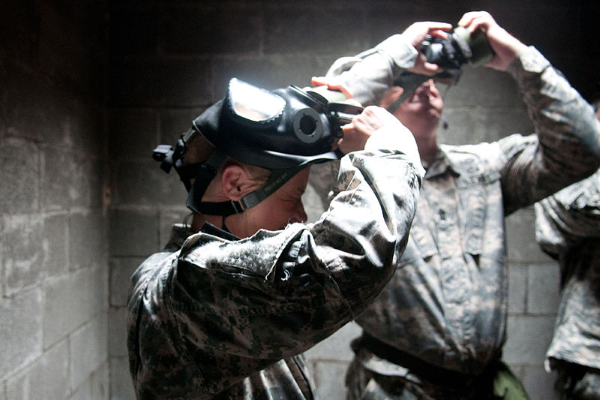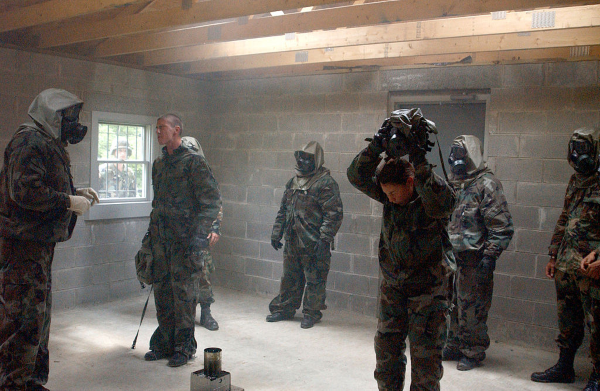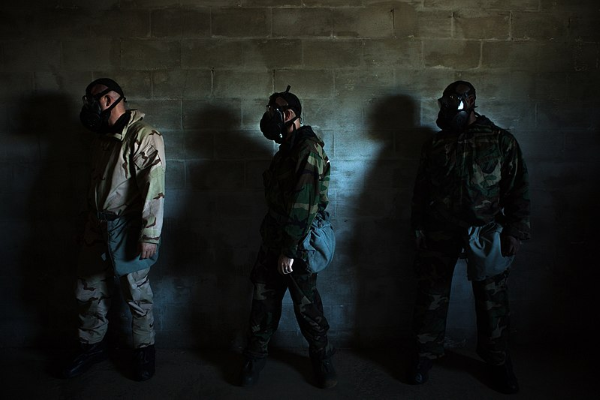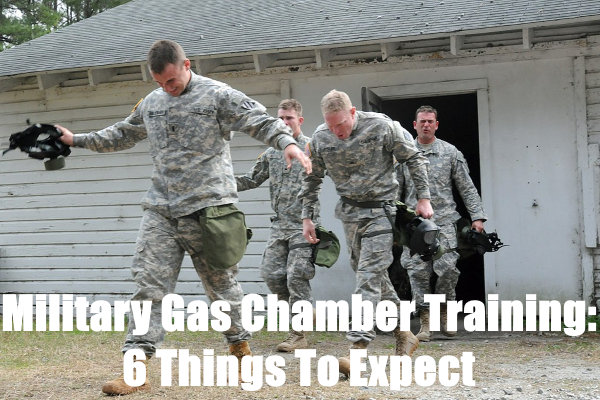Each branch of the military has its own version of the Gas Chamber during basic training.
It’s often considered the most challenging day of training because of the intense discomfort and the mental stress it places on the service member.
It may be scary for new recruits, but it is necessary.
They often consider it a rite of passage. However, the training has real world applications if they deploy the service member to a contaminated area.
Related Article – Army AIT: A List Of All 11 Locations + Training Summary
Table of Contents
What is Gas Chamber Training in the Military
The gas chamber is a part of the Armed Services chemical, biological, radiological, and nuclear defense (CBRN) program.
CBRN training prepares service members for the possibility of coming in contact with dangerous or deadly contaminants.
The gas chamber is considered familiarization training to ensure that service members know how to properly wear their protective equipment, which can save their lives in an emergency.
6 Things to Expect With Gas Chamber Training

Many serious members will tell you horror stories of their time in the gas chamber, but it would surprise you how safe the training is to complete.
#1. Pre-Training
Before entering the gas chamber, service members will get extensive training on CBRN.
One of the first things discussed is what CBRN is and how to prepare yourself to be deployed to a possibly dangerous area.
They discussed each threat to ensure that everyone knows the signs of a chemical attack and how to treat a person if they are exposed.
Because gas masks come in different sizes, each person pairs off with a buddy to ensure their mask properly fits their face.
A big part of the pre-training is equipment familiarization.
By understanding the function of the various components, a service member can identify an issue with their equipment, which can save their lives in a real life scenario.
#2. Different Levels of MOPP Gear
MOPP gear is the protective gear used to prevent you from being exposed to harmful chemicals or agents.
There are several levels of MOPP gear that you need to be familiar with, and it is gone over during the pre-training phase.
MOPP Ready means you can access your gear within two hours, and the second set in six.
You are at level zero when you have no protective gear on, but are immediately available.
At level one: you wear the suit, level two: suit and boots, level three: suit, boots, and mask, and level four: all gear is worn to include the gloves.
The gloves are the last layer of protective equipment because you lose a substantial amount of dexterity.
During basic training, expect to be at MOPP level four.
However, you should expect anything from just wearing the mask to MOPP level four while in the fleet.
Related Article – Navy Boot Camp Schedule
#3. Being Exposed in The Gas Chamber

During the gas chamber, you will be exposed to a controlled amount of CS gas, which is commonly known as tear gas.
The CS gas is introduced by melting the contents of capsules.
The gas will fill the room and make it seem foggy inside.
CS gas is an irritant and will cause you to be uncomfortable by a burning sensation of your eyes, skin, and lungs.
However, it does not cause any actual harm to you.
In most cases, it will feel like you got a sunburn until you shower, and you will cough.
That’s about it, so there is no need to freak out and try to b-line it out of the gas chamber because if you leave the gas chamber, you will need to go through the whole thing over again.
Just get it over with.
The gas chamber does not last that long, no matter what your buddy tells you.
The whole gas chamber experience only lasts for about five minutes or less, and generally, you are only exposed to the gas for less than a minute.
Based on the chamber size, you will generally be broken down into smaller groups of about 10-15 people.
Every chamber will make you break the seal of your gas mask, which will expose your face, eyes, and lungs to the gas.
After the seal is broken, part of the training is to get a good seal and clear the mask.
You will also perform other exercises such as jumping jacks and shaking your head back and forth to ensure that you have a solid seal.
A pro tip is to keep your eyes closed and hold your breath until you clear your mask.
You will still get exposed to the CS, but it would be less intense.
The critical part is that even if you start coughing, stay calm. It is almost over by this point.
One serious safety concern is that you should NEVER wear contact lenses when performing a gas chamber.
The crystals from the CS gas will get stuck on the contacts, causing them to fuse to your eyes.
So, on the training day, wear your glasses or nothing at all.
Related Article – 10 Best Military Tactical Sunglasses
#4. Inspect Your Gear
You will inspect your gas mask several times before entering the gas chamber.
If the military has ever issued you gear, you would know that it is not always completely operational, so it is essential to check your equipment.
Make sure that your canisters properly fit your mask and that you have all the small components that may fall off it.
For example, there is a white rubber seal that can easily fall off your mask located under the canister.
It will work fine while the canister is on, but once you conduct a filter swap in the gas chamber, you will not be able to clear your mask correctly, causing unnecessary irritation.
Any training canisters must have a blue indicator to show that they are for training only, such as the gas chamber,
You must get them swapped out for regular ones if you are deploying.
An interesting fact is that if you have prescription lenses, you can get specialty inserts made for your gas mask to ensure you can see correctly while wearing a gas mask.
#5. Decontamination
The decontamination phase is one of the biggest things about CBRN training that people forget to talk about.
Imagine being in a contaminated area where a nerve agent splashes against your suit.
You would not want to cross contaminate your buddy or accidentally get exposed to the agent.
The decontamination process is covered during the pre-training and is conducted once you leave the gas chamber for additional training.
You and a buddy will help each other take your MOPP suits off without getting exposed to the agents.
It may seem simple, but the process is time-consuming, and the gear such as the boots can be challenging to remove, especially while wearing the gloves.
#6. All Weather Training

This may not surprise service members, but they complete training no matter what the weather is like outside.
If you are caught in a downpour right before entering the gas chamber, the CS gas will stick you and cause additional irritation.
It is highly recommended that you bring your all weather gear with you and bring a second set of cammies to work.
You do not want to be in a contaminated uniform all day long because it will extend your discomfort and affect those around you even hours after the gas chamber.
Bring a towel with you in your day pack to wipe your face off if it is raining.
The last thing you want is to have CS crystals running down into your eyes after the chamber is complete.
Related Article – Army Class A, B, And C Uniforms Explained
Conclusion
The gas chamber may seem like a scary training event for those who have not experienced it before and may cause panic.
However, it is not as bad as you would imagine and is 90% mental.
An excellent way to look at it is if you freak out during the training and try to leave the gas chamber early, you will need to go through the entire thing again.
So, it is better to stay calm, listen to your instructors, and check your equipment before entering the chamber.
The CBRN training that service members go through is more than just the gas chamber.
They receive classes on identifying contaminants, decontamination, first-aid, and gear familiarization.
The first thing people think about when it comes to the gas chamber is the gas mask.
However, service members will use several levels of protective equipment based on the mission.
Even though the military trains with CS gas, the same process would also protect the service members from being exposed to a nerve, choking, blister, and other types of deadly agents.
The main objective in the gas chamber is to instill confidence in your ability to use your protective equipment when you need it.
Based on the service, the training will slightly change, and the frequency of training will change.
There is an annual requirement for United States Marines and Soldiers to complete the training.
However, based on the assigned unit’s mission, these requirements may change.
References / Resources
o-Chlorobenzylidene malononitrile
Chemical, Biological, Radiological and Nuclear (CBRN) Office | FEMA
See Also
Marine Corps CBRN Specialist (MOS 5711)
Army CBRN Specialist (MOS 74D): Career Details
- Ikon Pass Military Discount: Learn How To Save Big - January 31, 2025
- RTIC Military Discount: Find Out How To Save Big on Gear - January 30, 2025
- Traeger Military Discount: Learn How To Save Big on Smokers - January 28, 2025





